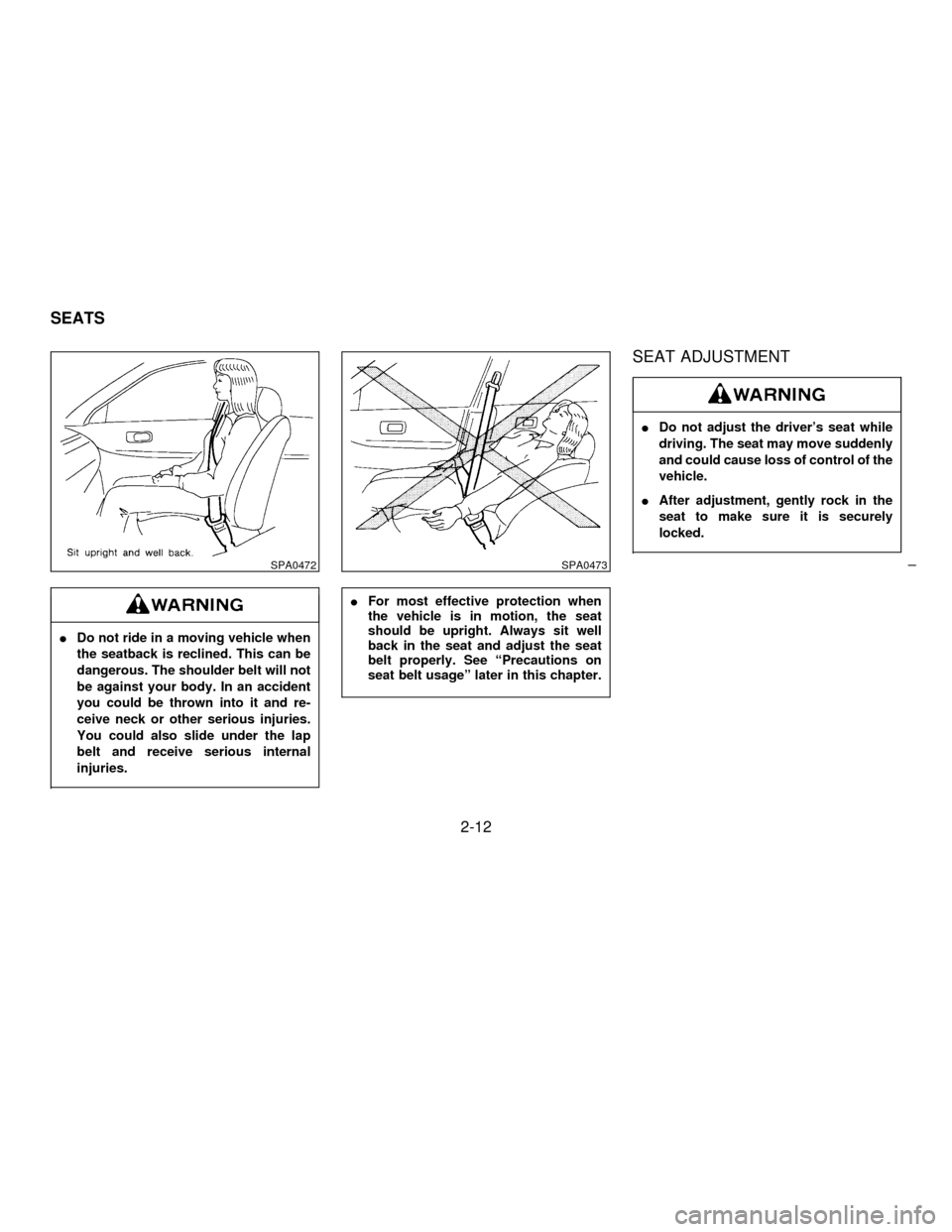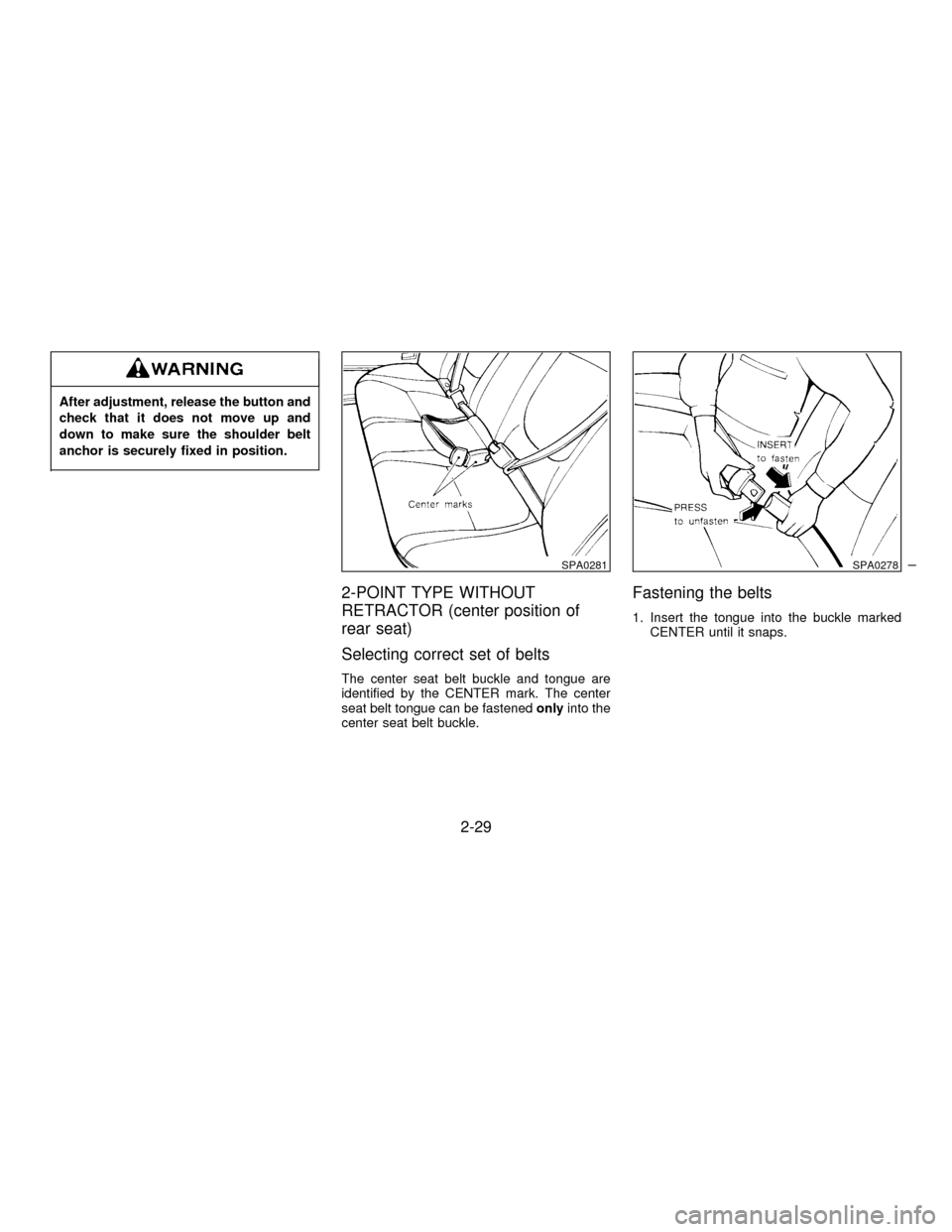1997 NISSAN MAXIMA seat adjustment
[x] Cancel search: seat adjustmentPage 12 of 215

belt is loose, broken, missing or if the light
remains on, see your NISSAN dealer immedi-
ately.
Do not continue driving if the belt is
loose, broken or missing.
Door open warning light
This light comes on when any of the doors are
not closed securely while the ignition key is
ªONº.
Seat belt warning light and
buzzer
The light and buzzer remind you to fasten seat
belts. The light illuminates whenever the igni-
tion key is turned to ªONº, and will remain
illuminated until the driver's seat belt is fas-
tened. At the same time, the buzzer will sound
for about six seconds unless the driver's seat
belt is securely fastened.
Refer to ªSeat beltsº in the ªPre-driving checks
and adjustmentsº section for precautions on
seat belt usage.
Supplemental air bag warning
light
When the ignition key is in the ªONº or
ªSTARTº position, the supplemental air bag
light will illuminate for about 7 seconds and
then turn off. This means the system is opera-
tional.
If any of the following conditions occur, the
supplemental air bag needs servicing and your
vehicle must be taken to your nearest autho-
rized NISSAN dealer.
1. The supplemental air bag light goes off
within 7 seconds.
2. The supplemental air bag light flashes in-
termittently or remains on (after 7 seconds).
3. The supplemental air bag light does not
come on at all.
Unless checked and repaired, the Supplemen-
tal Restraint System may not function properly.
For additional details on the Supplemental Air
Bag System, see Section 2.
If the supplemental air bag warning light
is on, it could mean that the supplemen-
tal air bag will not operate in anaccident.
Low washer fluid warning
light (If so equipped)
This light comes on when the washer tank fluid
is at a low level. Add washer fluid as neces-
sary. See the ªDo-it-yourself operationsº sec-
tion.
orBrake warning light
This light functions for both the parking brake
and the foot brake systems.
Parking brake indicator
The light comes on when the parking brake is
applied.
Low brake fluid warning
The light warns of a low brake fluid level. If the
light comes on while the engine is running with
the parking brake not applied, stop the vehicle
and perform the following:
1. Check the brake fluid level. Add brake fluid
as necessary. See ªBrake and clutch fluidº
in the ªDo-it-yourself operationsº section.
1-7
Z01.2.1/A32-DX
Page 34 of 215

2 Pre-driving checks and adjustments
Key ............................................................................ 2-2
Door locks ................................................................. 2-2
Multi-remote control system (If so equipped) ........... 2-5
Hood release ............................................................. 2-8
Glove box lock .......................................................... 2-8
Trunk lid lock ............................................................. 2-9
Fuel filler lid lock ..................................................... 2-10
Seats ....................................................................... 2-12
Supplemental restraint system
(Supplemental air bag system) ............................... 2-17
Supplemental air bag warning labels ...................... 2-22
Supplemental air bag warning light......................... 2-22
Seat belts ................................................................ 2-24
Child restraints for infants and small children......... 2-31
Tilting steering wheel .............................................. 2-38
Outside mirror remote control ................................. 2-39
Foldable outside mirrors.......................................... 2-39
Inside mirror ............................................................ 2-40
Z01.2.1/A32-DX
Page 45 of 215

IDo not ride in a moving vehicle when
the seatback is reclined. This can be
dangerous. The shoulder belt will not
be against your body. In an accident
you could be thrown into it and re-
ceive neck or other serious injuries.
You could also slide under the lap
belt and receive serious internal
injuries.
IFor most effective protection when
the vehicle is in motion, the seat
should be upright. Always sit well
back in the seat and adjust the seat
belt properly. See ªPrecautions on
seat belt usageº later in this chapter.
SEAT ADJUSTMENT
IDo not adjust the driver's seat while
driving. The seat may move suddenly
and could cause loss of control of the
vehicle.
IAfter adjustment, gently rock in the
seat to make sure it is securely
locked.
SPA0472SPA0473
SEATS
2-12
Z01.2.1/A32-DX
Page 61 of 215

3-point seat belts have a cinching mechanism
for child seat installation. It is referred to as the
automatic locking mode.
When the cinching mechanism is activated the
seat belt cannot be withdrawn again until the
seat belt tongue is detached from the buckle
and fully retracted. Refer to ªChild restraints for
infants and small childrenº later in this section
for more information.
The automatic locking mode should be
used only for child seat installation. During
normal seat belt use by a passenger, the
locking mode should not be activated. If it
is activated it may cause uncomfortable
seat belt tension.
Unfastening the belts
To unfasten the belt, press the button on the
buckle. The seat belt will automatically retract.
Checking seat belt operation
(3-point type with retractor)
Your seat belt retractors are designed to lock
belt movement using two separate methods:
1) When the belt is pulled quickly from the
retractor.
2) When the vehicle slows down rapidly.
You can check their operation as follows:
IGrasp the shoulder belt and pull quickly
forward. The retractor should lock and re-
strict further belt movement.
If the retractor does not lock during this check
or if you have any questions about belt opera-
tion, see your NISSAN dealer.
Shoulder belt height adjustment
(For front seats)
The shoulder belt anchor height should be
adjusted to the position best for you. (See
ªPrecautions on seat belt usageº.) To adjust,
squeeze the release buttons, and then move it
to the desired position, so that the belt passes
over the center of the shoulder. The belt
should be away from your face and neck, but
not falling off of your shoulder.
PD1321-A
2-28
Z01.2.1/A32-DX
Page 62 of 215

After adjustment, release the button and
check that it does not move up and
down to make sure the shoulder belt
anchor is securely fixed in position.
2-POINT TYPE WITHOUT
RETRACTOR (center position of
rear seat)
Selecting correct set of belts
The center seat belt buckle and tongue are
identified by the CENTER mark. The center
seat belt tongue can be fastenedonlyinto the
center seat belt buckle.
Fastening the belts
1. Insert the tongue into the buckle marked
CENTER until it snaps.
SPA0281SPA0278
2-29
Z01.2.1/A32-DX
Page 64 of 215

SEAT BELT MAINTENANCE
ITo clean the seat belt webbings,apply a
mild soap solution or any solution recom-
mended for cleaning upholstery or carpets.
Then brush the webbing, wipe it with a cloth
and allow it to dry in the shade. Do not allow
the seat belts to retract until they are com-
pletely dry.
IIf dirt builds up in the shoulder belt guide of
the seat belt anchors, the seat belts may
retract slowly. Wipe the shoulder belt guide
with a clean, dry cloth.
IPeriodically check to see that the seat
belt and the metal componentssuch as
buckles, tongues, retractors, flexible wires
and anchors work properly. If loose parts,
deterioration, cuts or other damage on the
webbing is found, the entire belt assembly
should be replaced.
IInfants and small children should al-
ways be placed in an appropriate
child restraint while riding in the ve-
hicle. Failure to use a child restraint
can result in serious injury or death.
IChildren and infants should never be
carried on your lap. It is not possible
for even the strongest adult to resist
the forces of a severe accident. The
child could be crushed between the
adult and parts of the vehicle. Also,
do not put the same seat belt around
both your child and yourself.
INissan recommends that the child
restraint be installed in the rear seat.
According to accident statistics, chil-
dren are safer when properly re-
strained in the rear seat than in the
front seat.
IAn improperly installed child re-
straint could lead to serious injury or
death in an accident.
In general, child restraints are designed to beinstalled with a lap belt or the lap portion of a
three-point type seat belt.
Child restraints specially designed for infants
and small children are offered by several
manufacturers. When selecting any child re-
straint, keep the following points in mind:
1) Choose only a restraint with a label certify-
ing that it complies with Federal Motor
Vehicle Safety Standard 213 or Canadian
Motor Vehicle Safety Standard 213.
2) Check that child restraint in your vehicle to
be sure it is compatible with the vehicle's
seat and seat belt system. Choose a child
restraint that meets the guidelines of the
Society of Automotive Engineers recom-
mended practice J1819 for child restraint
installation.
3) If the child restraint is compatible with your
vehicle, place your child in the child re-
straint and check the various adjustments
to be sure the child restraint is compatible
with your child. Always follow all recom-
mended procedures.
All U.S. states and provinces of Canada
require that infants and small children be
restrained in approved child restraints at
all times while the vehicle is being oper-
ated.
CHILD RESTRAINTS FOR
INFANTS AND SMALL CHILDREN
2-31
Z01.2.1/A32-DX
Page 66 of 215

Installation on rear center seating
position
When you install a child restraint in a rear
center seat, follow these steps:
1. Position the child restraint on the seat as
illustrated. It can be placed in a front facing
or rear facing direction, depending on the
size of the child. Always follow the restraint
manufacturer's instructions.
2. Route the seat belt tongue through the child
restraint and insert it into the buckle until
you hear and feel the latch engage.
Be sure to follow the child restraint manu-facturer's instructions for belt routing.
3. Remove all slack in the lap belt for a very
tight fit by pulling forcefully on the lap belt
adjustment.
4. Before placing the child in the child re-
straint, use force to tilt the child restraint
from side to side, and tug it forward to make
sure that it is securely held in place.
5. If it is not secure, try to tighten the belt
again, or put the restraint in another seat.
6. Check to make sure the child restraint is
properly secured prior to each use.
SPA0276PD1174
2-33
Z01.2.1/A32-DX
Page 213 of 215

S
Safety
Child safety rear door lock .......................... 2-3
Reporting safety defects (For U.S.A.) ....... 9-19
Seat adjustment .............................................. 2-12
Seat belt
2-point type without retractor .................... 2-29
3-point type seat belt with ......................... 2-26
Precautions on seat belt usage ................ 2-24
Seat belt extenders ................................... 2-30
Seat belt maintenance .............................. 2-31
Seat belts .................................................. 2-24
Seats ............................................................... 2-12
Spark plug replacement .................................. 7-15
Speedometer .................................................... 1-4
Starting
Before starting the engine ........................... 4-6
Jump starting ..................................... 5-7, 7-14
Precautions when starting and driving ........ 4-2
Push starting ............................................... 5-9
Starting the engine ...................................... 4-6
Steering
Power steering fluid................................... 7-11
Power steering system .............................. 4-17
Tilting steering wheel ................................ 2-38
Sunroof (If so equipped) ................................. 1-21
Supplemental air bag warning light ................ 2-22
Supplemental restraint system (Supplemental air
bag system) .................................................... 2-17
Switch
Front fog light switch (If so equipped) ...... 1-15
Hazard warning flasher switch .................. 1-16
Headlight and turn signal switch ............... 1-14Ignition switch .............................................. 4-4
Rear window and outside mirror defogger
switch......................................................... 1-13
Windshield wiper and washer switch ........ 1-12
T
Tachometer ....................................................... 1-4
Theft warning (If so equipped)........................ 1-10
Three way catalyst ............................................ 4-2
Tilting steering wheel ...................................... 2-38
Timing chain ..................................................... 9-8
Tire
Flat tire ........................................................ 5-2
Tire chains ................................................. 7-31
Tire placard ............................................... 9-12
Tire pressure ............................................. 7-30
Uniform tire quality grading ....................... 9-18
Wheels and tires ................................ 7-30, 9-9
Tow truck towing ............................................. 5-10
Towing
Tow truck towing ....................................... 5-10
Towing load/specification chart ................. 9-15
Trailer towing ............................................. 9-14
Trailer towing .................................................. 9-14
Transmission
Automatic transmission fluid ..................... 7-10
Driving with automatic transmission............ 4-7
Driving with manual transmission ............. 4-10
Trip odometer ................................................... 1-4
Trunk lid lock .................................................... 2-9
Trunk lid opener operation ............................... 2-6
Trunk light ....................................................... 1-23U
Uniform tire quality grading............................. 9-18
V
Vanity mirror light ............................................ 1-23
Vehicle identification ....................................... 9-10
Vehicle identification number (Chassis
number) ..................................................... 9-10
Vehicle identification number plate ........... 9-10
Vehicle loading information............................. 9-13
Vehicle recovery (Freeing a stuck
vehicle)............................................................ 5-12
Ventilator ........................................................... 3-2
W
Warning
Hazard warning flasher switch .................. 1-16
Supplemental air bag warning labels ........ 2-22
Supplemental air bag warning light........... 2-22
Theft warning (If so equipped) .................. 1-10
Warning/indicator light and buzzer.............. 1-6
Wheels and tires ..................................... 7-30, 9-9
Window washer fluid ....................................... 7-12
Windshield wiper and washer switch.............. 1-12
Wiper
Windshield wiper and washer switch ........ 1-12
Wiper blades ............................................. 7-18
10-4
Z01.2.1/A32-DX